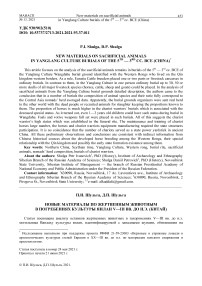New materials on sacrificial animals in Yanglang culture burials of the 5th - 3rd cc. BCE (China)
Автор: Shulga P.I., Shulga D.P.
Журнал: Материалы по археологии и истории античного и средневекового Причерноморья @maiask
Рубрика: Археология
Статья в выпуске: 13, 2021 года.
Бесплатный доступ
This article focuses on the analysis of the sacrificial animals remains in burials of the 5th - 3rd сс. BCE of the Yanglang Culture Wangdahu burial ground identified with the Western Rongs who lived on the Qin kingdom western borders. As a rule, Eurasia Cattle breeders placed one or two parts or livestock carcasses in ordinary burials. In contrast to them, in the Yanglang Culture in one person ordinary burial up to 30, 50 or more skulls of all major livestock species (horses, cattle, sheep and goats) could be placed. In the analysis of sacrificial animals from the Yanglang Culture burial grounds detailed description, the authors came to the conclusion that in a number of burials the composition of animal species and their ratio fully correspond to the Central Asia nomads’ herd averaged data. Apparently, the burial grounds organizers were sent real herd to the other world with the dead people or recruited animals for slaughter keeping the proportions known to them. The proportion of horses is much higher in the chariot warriors` burials which is associated with the deceased special status. As it turned out, even 1-3 years old children could have such status during burial in Wangdahu. Foals and votive weapons full set were placed in such burials. All of this suggests the chariot warrior’s high status which was established in the funeral rite. The maintenance and training of chariot horses large number, the horses and chariot warriors equipment manufacturing required the state structures participation. It is no coincidence that the number of chariots served as a state power yardstick in ancient China. All these preliminary observations and conclusions are consistent with indirect information from Chinese historical sources about the developed horse breeding among the Western Rongs, their special relationship with the Qin kingdom and possibly the early state formation existence among them.
Northern china, scythian time, yanglang culture, western rong, burial rite, sacrificial animals, nomads' herd composition, burials of chariot warriors
Короткий адрес: https://sciup.org/14123572
IDR: 14123572
Список литературы New materials on sacrificial animals in Yanglang culture burials of the 5th - 3rd cc. BCE (China)
- Beijing City Institute of Cultural Heritage. 2007. Burial Grounds in the Jundushan Mountains: Yuhuangmiao (in 4 volumes).
- Beijing: Wenwu chubanshe. Institute of Archeology and Material Culture 2014: Institute of Archeology and Material Culture of Gansu County. 2014. Archaeological treasures of the Western Rong (based on materials from the Majiayuan burial ground of the Zhanguoperiod). Beijing: Wenwu chubanshe.
- Institute of Archeology and Cultural Heritage 2016: Institute of Archeology and Cultural Heritage of Ningxia Hui AR, Pengyang County Cultural Heritage Office. 2016.
- Wangdahu and Jiulongshan — burial grounds of the Northern Bronze culture (in 2 volumes). Beijing: Wenwu chubanshe. Kradin, N.N. 2001. Hunnu Empire. Moscow: Logos.
- Kryukov, M.V., Sofronov, M.V., Cheboksarov, N.N. 1978. Ancient Chinese: Problems of Ethnogenesis. Moscow: GRVL.
- Markov, G.E. 1976. Nomads of Asia. Moscow: Moskow University.
- Shulga, P.I. 2015a. Yuhuangmiao burial ground in North China (VII—VI centuries BC). Novosibirsk: IAET SB RAS.
- Shulga, P.I. 2015b. Cattle breeders of Altai Mountains in the Scythian time (based on settlements materials). Novosibirsk: RIC NSU.
- Shulga, D.P., Shulga, P.I. 2019. Wangdahu burial ground of the Yanglang Culture in the Ningxia-Hui Autonomous Region of the PRC. Problems of archeology, ethnography, anthropology of Siberia and adjacent territories 25, 649—656.
- Tian Guangjin, Guo Xuxin. 1986. Ordos style bronzes. Beijing: Wenwu chubanshe.
- Wu Xiaolong. 2013. Cultural hybridity and social status: elite tombs on Chinas Northern Frontier during the third century BC. Antiquity 87:335, 121—136.
- Xu Cheng, Li Jinzeng, Wei Zhong, Han Xiaoman, Yan Shizhong. 1993. Burial ground of the Yanlan bronze culture in Guyuan, Ningxia. Kaogu xuebao 3, 13.
- Yang Jianhua. 2004. Formation of archaeological cultures of the China northern belt during the Chunqiu and Zhanguo periods. Beijing: Wenwu chubanshe.
- Zheng Junlei. 2003. On the criteria for distinguishing nomadic pastoralists heritage — the northern belt along the Great Wall from Xia to Eastern Zhou. Bianjiang kaogu yanjiu. Archaeological research of the border area 2, 425—451.


